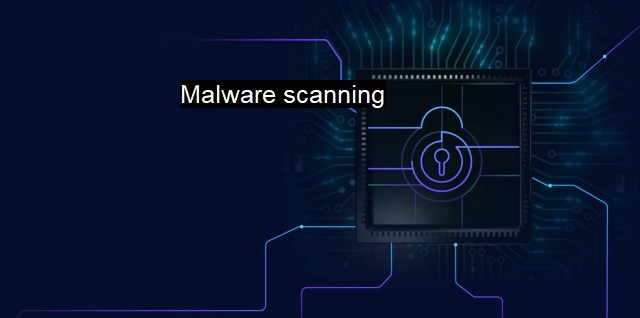What is Malware scanning?
Keeping Cyber Threats at Bay: The Importance of Malware Scanning in Today’s Digitized World"
Malware scanning refers to the process adopted by cybersecurity software to inspect and identify harmful software called malware in computer systems and networks. The term "Malware scanning" is used across cybersecurity applications—including those related to antivirus, antispyware, and anti-ransomware systems—signifying that all these use similar methodologies for detecting viruses or security threats. It forms an essential prevention layer against cybercrime, diminishing the potential risks of data and privacy compromise.Malware is malicious software designed with an aim to cause harm; it may take various forms including viruses, trojans, worms, ransomware, and spyware. Each form carries out different damaging activities ranging from deleting files to stealing sensitive information or disrupting system operations. Notably, malware these days is becoming increasingly sophisticated, which underlines the necessity for scanning algorithms that can effectively identify and counteract these threats.
Malware scanning primarily works based on two types of methodologies: signature-based scanning and heuristic/behavior-based scanning.
Signature-based scanning is the traditional method used by an antivirus software to detect malware efficiently. It scans the files and compares them with a repository of known malware signatures-think of them as fingerprints of the code. If the scanners detect a segment of code that matches an existing malware signature in their database, the file is flagged as malware and treated accordingly. This approach allows for the detection of both known and common threats effectively. one of the shortcomings is that it can't recognize newly released malware—or zero-day threats—that don't yet have known signatures.
On the other hand, heuristic scanning or behavior-based scanning proves helpful in detecting such threats. Instead of matching signatures, this approach monitors activity or behavior patterns. When the software identifies a suspicious action with a potential security risk, it flags it as high-risk behavior. This can include accessing certain locations of the hard drive, modifying specific files, or even a high level of hard drive read/writes. This type of scanning helps in identifying yet unknown malware because it’s based on behavior instead of coding signatures, and this allows it to detect zero-day threats proactively.
With increase in cyber-criminals using highly sophisticated malware that can change its signature or behavior, many antivirus software now adopt real-time protection features. These go above and beyond the regular scope of malware scanning and give the user a greater degree of visibility and control over the state of their system. They further aid businesses and individuals by preventing data breaches and significant losses. there is a rise of multi-layered security systems, including firewalls alongside antiviruses, bolster the capabilities of hazard prevention applications.
While malware scanners act as reliable watchtowers against cyber threats, they do have limitations. For one, they can only defend against known tread attributes. Over-researching or overly-subtle malware can sometimes go past even the most robust antivirus systems unnoticed. Take for example the aforementioned zero-day exploits. Plus, occasionally, the antiviruses may raise false alarms indicating a normal file as malware, thereby causing unnecessary concern or disturbance. Hence the need for continuous refinement and evolution.
Considering the above, it is evident that malware scanning is no longer an option—it is a necessity. As the line between digital and physical realities keeps blurring and as the compromise of cybersecurity continues to have more and more serious implications, proactive protective measures are a must. Maintaining regular malware scans, software updates, and educating oneself about the evolving methods of cybercriminals, can help users anticipate and protect against these uninvited trespassers. Cybersecurity, undoubtedly, needs to perpetually evolve to tackle the complexities of cyber threats and malware scanning plays a pivotal role here.

Malware scanning FAQs
What is malware scanning?
Malware scanning is the process of using antivirus software to search for and identify malicious software, such as viruses, Trojan horses, worms, and spyware, on a computer or network.What is the importance of malware scanning?
Malware scanning is important because it helps to protect your computer and network from potential cybersecurity threats. It can detect and remove malware, prevent data breaches, and keep your personal and sensitive information safe.How does malware scanning work?
Malware scanning works by using antivirus software to scan your computer or network for known malware signatures or patterns. The antivirus software may also use heuristic analysis to identify suspicious behavior or code that could be malware. If malware is detected, the antivirus software will either quarantine or delete the infected files.How often should I perform malware scanning?
It is recommended to perform malware scanning on a regular basis, such as daily or weekly, depending on your level of internet activity and exposure to potential malware threats. It is also important to perform malware scanning after any suspicious activity, such as downloading a file or visiting a suspicious website.| | A | | | B | | | C | | | D | | | E | | | F | | | G | | | H | | | I | | | J | | | K | | | L | | | M | |
| | N | | | O | | | P | | | Q | | | R | | | S | | | T | | | U | | | V | | | W | | | X | | | Y | | | Z | |
| | 1 | | | 2 | | | 3 | | | 4 | | | 7 | | | 8 | | |||||||